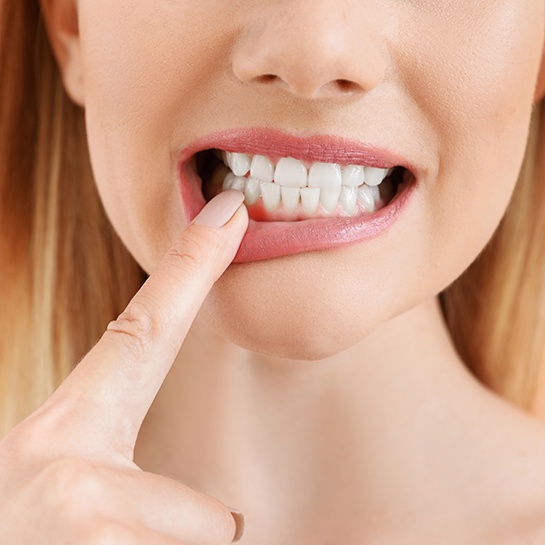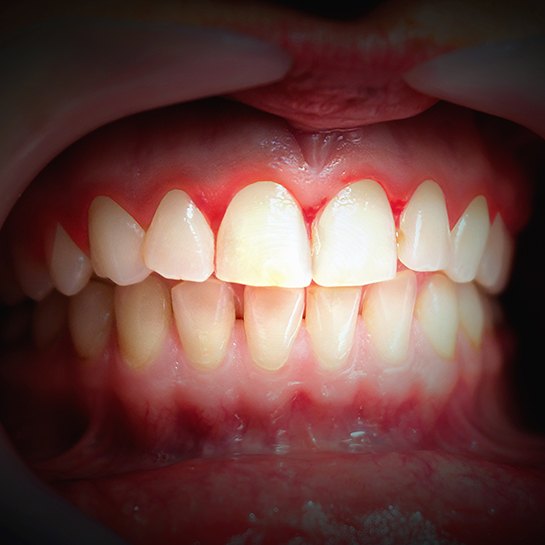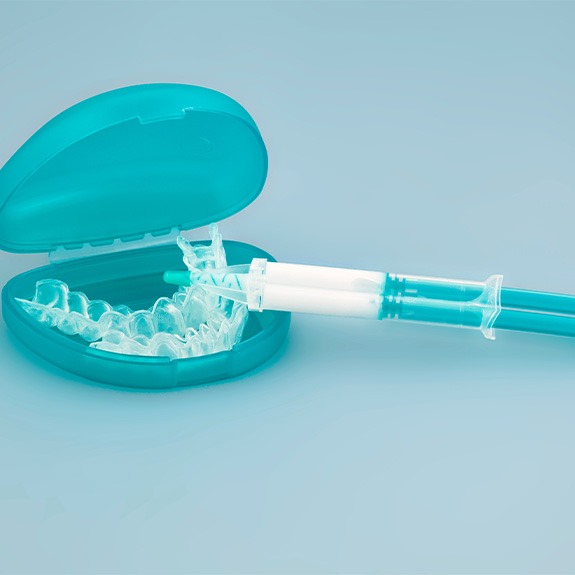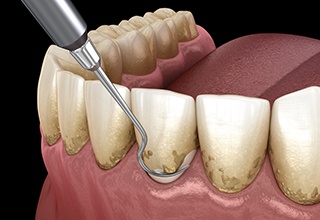Gum Disease Treatment – Weatherford, TX
The Health of Your Gums Matters
When it comes to maintaining a healthy mouth, your primary concern may be protecting your teeth from cavities. However, your gums also deserve your attention. If gum disease is allowed to develop, it could eventually lead to tooth loss and put you at a higher risk for heart disease. While our team at Beacon Dentistry of Weatherford will strive to prevent gum disease whenever possible, we also offer options for treating the problem before it can grow worse. Call us today if you think you may need gum disease treatment soon.
Why Choose Beacon Dentistry of Weatherford for Gum Disease Treatment?
- Gentle, Thorough Scaling and Root Planing
- Reliable Arestin Antibiotic Treatments
- Comfortable Modern Office with Advanced Technology
What is Gum Disease?

If plaque and tartar are allowed to build up in your mouth, they can result in an infection of the gums known as gum disease. The earliest stage of gum disease, gingivitis, is relatively mild; oftentimes, it may even be possible to reverse it just by making some improvements to your oral hygiene routine. However, gingivitis can eventually turn into periodontitis, which is a much more serious oral health threat that cannot be fully cured and must be managed so that it doesn’t grow worse.
Symptoms of Gum Disease

You may have gum disease if you have noticed any of the following symptoms:
- Your gums are unusually red or swollen.
- Your teeth look longer than normal due to gum recession.
- Your gums tend to bleed very easily, especially when you brush or floss.
- There have been changes in your bite.
- Some of your permanent teeth have come loose.
Gum disease doesn’t always have obvious symptoms early on. Luckily, our team can often catch warning signs that you might have missed during a routine checkup.
How Do We Treat Gum Disease?

Our team will need to take a close look at your gums in order to determine how severe your gum disease is. Once that’s done, we can work with you to figure out which form of treatment is right for your smile. Here’s a closer look at your options.
Antibiotic Treatment

To help fight the hard-to-reach bacteria that are contributing to your gum disease, we may recommend Arestin antibiotic treatment. Arestin consists of a number of microspheres that are meant to be placed in the pockets that form between the teeth and gums as a consequence of gum disease. The microspheres gradually release medication into the gums, killing harmful bacteria and promoting healing.
Perio Protect

Protecting your gums from the threat of reoccurring infection has never been so easy and convenient. Perio Protect allows our patients to reduce their risk of consequential health conditions that can arise due to unchecked gum disease by simply placing a small amount of prescription gel over your gumline and teeth at home after you brush and floss.
Learn More About Perio Protect
Scaling & Root Planing

Scaling and root planing is a two-step process used to stop gum disease in its early stages. First, your dental team will clear away all the plaque and tartar from above and below your gumline. This helps keep harmful bacteria under control and prevents it from further accumulation, restoring the health of your oral tissues and reducing inflammation and tenderness. Once this is complete, we will smooth out the roots of your teeth so your gums can healthily reattach to your teeth.
Do I Need Scaling & Root Planing?

If you have noticed warning signs of gum disease like bleeding while brushing and flossing, receding gums, chronic bad breath, visible plaque buildup, or swollen or puffy gums, you may be a good candidate for scaling and root planing.
The early stages of gum disease can often be remedied by good at-home oral hygiene practices, including brushing and flossing. However, if it has progressed too far, scaling and root planing may be necessary to stop it from getting worse.
The Process of Scaling & Root Planing

Typically, the scaling and root planing process takes place over the course of two appointments:
- Appointment #1: Your dental team will use a scaler to clear away all the plaque and tartar from the surface of your teeth as far down as the pockets of your gums.
- Appointment #2: The planing part of the treatment is when your dentist removes any hardened bacterial deposits on the roots of your teeth that are hidden below the gumline. This will help prevent further infection by keeping the bacteria from recolonizing in your gums.
Aftercare Tips for Scaling & Root Planing

Because scaling and root planing can be an intensive treatment, it could take several weeks for your teeth and gums to recover. It is not uncommon to experience increased sensitivity and discomfort as a natural part of the healing process. Here are some general aftercare tips:
- Rinse your gums with warm saltwater after each meal to prevent irritation and loosen food and debris from around your teeth. This will make flossing and brushing easier. To make the saltwater, combine ¼ teaspoon of salt with eight ounces of water.
- Brush gently after treatment and use a soft-bristled toothbrush. Brush in small, circular motions and move very slowly.
- Be sure to avoid hot and spicy foods as well as alcohol and acidic drinks, as these may cause inflammation and irritation. Also, avoid smoking and using tobacco products.
- Eat a soft diet for the first 48 hours following your treatment.
- Avoid any intensive physical activity directly after your procedure, as this could delay your healing process.
Gum Disease Treatment FAQs
Can I Have Gum Disease Without Bleeding Gums?
There are indeed cases where patients develop gum disease but don’t experience bleeding gums. This can be a consequence of smoking, as tobacco products can reduce blood flow to the mouth. Alternatively, a lack of bleeding could mean that you’re brushing your teeth in a way that doesn’t stimulate the gum tissues.
If you suspect that you have gum disease but haven’t noticed any bleeding of the gums, you should schedule an appointment with our team anyway. We can perform a thorough examination of your mouth to check for telltale signs of a gum infection that you might not have noticed on your own.
Can Gum Disease Cause Bad Breath?
Yes, constant bad breath is often a symptom of gum disease. The underlying cause of gum disease is the buildup of harmful oral bacteria on your teeth and gums. These bacteria can feed off the sugar in the foods you eat and produce volatile sulfur compounds as a byproduct, thus giving your breath an unpleasant odor. Simply brushing your teeth won’t be enough to make the smell go away; you’ll need to have your gum disease properly treated by a trained dental professional to truly address the problem.
Why are Scaling and Root Planing Necessary for Treating Gum Disease?
When your mouth is in good health, a regular preventive cleaning is typically enough to maintain good oral hygiene. However, when you have gum disease, significant amounts of harmful bacteria tend to accumulate in the pockets between your teeth and gums. A normal dental cleaning won’t address these areas. As such, scaling and root planing are typically required to get rid of the bacteria that are hiding beneath your gums so that your mouth has a chance to heal.
How Long Will Scaling and Root Planing Take?
One scaling and root planing session can typically be completed in about one to two hours. That said, the treatment will most likely require you to schedule two or more appointments; a different part of your mouth will be cleaned during each visit.
Naturally, the timeline for scaling and root planing isn’t set in stone. Depending on how much plaque and tartar need to be removed, your own treatment could be longer or shorter than that of another patient.
How Much Does Gum Disease Treatment Cost?
We can only give you an estimate of the overall cost of gum disease treatment once we’ve carefully considered your unique situation. The severity of your gum disease, the type of treatment required, and various other factors could have an impact on the final price tag. Additionally, your dental insurance plan may be willing to help pay for gum disease treatment in Weatherford, but coverage can vary depending on what plan you have.
If you’re worried about your ability to pay the full cost of gum disease all at once, you may want to consider applying for financing through CareCredit, Sunbit, Cherry, or Proceed Finance. Using financing to break up the cost of your care can make things much easier on your bank account.

